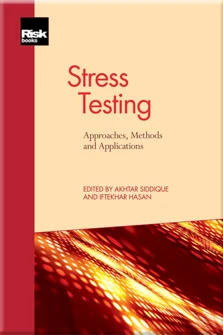EU-Wide Stress Test: The Experience of the EBA
Paolo Bisio, Demelza Jurcevic and Mario Quagliariello
Introduction to Stress Testing: Approaches, Methods and Applications
Governance over Stress Testing
Stress Testing and Other Risk-Management Tools
Stress Testing for Market Risk
The Evolution of Stress Testing Counterparty Exposures
Operational Risk: An Overview of Stress-Testing Methodologies
Stress Testing of Bank Loan Portfolios as a Diagnostic Tool
Stress-Test Modelling for Loan Losses and Reserves
A Framework for Stress Testing Banks’ Corporate Credit Portfolio
EU-Wide Stress Test: The Experience of the EBA
Stress Testing Across International Exposures and Activities
Liquidity Risk: The Case of the Brazilian Banking System
Determining the Severity of Macroeconomic Stress Scenarios
In the midst of the financial crisis, the European Banking Authority (EBA) was established on January 1, 2011, with a broad remit that included safeguarding the stability of the EU financial system.11 High Level Group on Financial Supervision in the EU published a report in February 2009, the so-called De Larosière Report. The aim of the report was to lay out a framework to take the EU further in its process of integration, which includes (i) a new regulatory agenda (Basel III), (ii) stronger coordinated supervision (eg, EBA) and (iii) effective crisis-management procedures. According to its founding regulation,22 Regulation (EU) No. 1093/2010 of the European Parliament and of the Council of November 24, 2010. the EBA is required, in cooperation with the European Systemic Risk Board (ESRB), to initiate and coordinate EU-wide stress tests to assess the resilience of financial institutions to adverse market developments. While the stress test is a key component of the EBA’s toolkit, it is only one of a range of supervisory tools used by the EBA for assessing the resilience of individual institutions as well as the overall resilience of the European banking system.
The first EU-wide
Copyright Infopro Digital Limited. All rights reserved.
As outlined in our terms and conditions, https://www.infopro-digital.com/terms-and-conditions/subscriptions/ (point 2.4), printing is limited to a single copy.
If you would like to purchase additional rights please email info@risk.net
Copyright Infopro Digital Limited. All rights reserved.
You may share this content using our article tools. As outlined in our terms and conditions, https://www.infopro-digital.com/terms-and-conditions/subscriptions/ (clause 2.4), an Authorised User may only make one copy of the materials for their own personal use. You must also comply with the restrictions in clause 2.5.
If you would like to purchase additional rights please email info@risk.net











